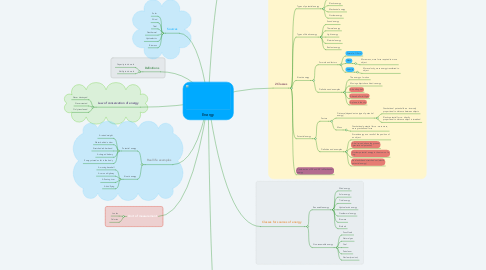
1. Definitions
1.1. Capacity to do work
1.2. Ability to do work
2. Sources
2.1. Solar
2.2. Wind
2.3. Tidal
2.4. Geothermal
2.5. Hydroelectric
2.6. Biomass
3. Law of conservation of energy
3.1. Never destroyed
3.2. Never created
3.3. Only transferred
4. Real life examples
4.1. Potential energy
4.1.1. A raised weight
4.1.2. Water behind a dam
4.1.3. Stretched rubber band
4.1.4. A charged battery
4.1.5. Energy stored as fat in the body
4.2. Kinetic energy
4.2.1. A moving baseball
4.2.2. A car on a highway
4.2.3. A flowing river
4.2.4. A bird flying
5. Unit of measurement
5.1. Joules
5.2. Calories
6. Different Forms (general)
6.1. Mechanical energy
6.2. Nuclear energy
6.3. Thermal energy
6.4. Gravitational energy
6.5. Electrical energy
6.6. Kinetic energy
6.7. Chemical energy
6.8. Elastic energy
7. 2 Classes
7.1. Types of potential energy
7.1.1. Chemical energy
7.1.2. Elastic energy
7.1.3. Mechanical energy
7.1.4. Nuclear energy
7.2. Types of kinetic energy
7.2.1. Sound energy
7.2.2. Thermal energy
7.2.3. Light energy
7.2.4. Electrical energy
7.2.5. Radiant energy
7.3. Kinetic energy
7.3.1. Formula and factors
7.3.1.1. Formula: 1/2 mv²
7.3.1.2. Mass
7.3.1.2.1. More mass, more force required to move object
7.3.1.3. Velocity
7.3.1.3.1. More velocity, more energy transferred to object
7.3.2. Definition and examples
7.3.2.1. The energy of motion
7.3.2.2. Moving objects have kinetic energy
7.3.2.3. A bowling ball
7.3.2.4. A baseball mid-flight
7.3.2.5. A plane in the sky
7.4. Potential energy
7.4.1. Factors
7.4.1.1. Distance (dependent on type of potential energy)
7.4.1.1.1. Gravitational potential force - inversely proportional to distance between objects
7.4.1.1.2. Elastic potential force - directly proportional to distance object is stretched
7.4.1.2. Mass
7.4.1.2.1. Gravitational potential force - more mass, more gravitational force
7.4.2. Definition and examples
7.4.2.1. Stored energy as a result of the position of an object
7.4.2.2. A ball raised above the ground (gravitational potential)
7.4.2.3. Nuclear potential energy in the atoms of a log
7.4.2.4. An elastic band stretched out (elastic potential energy)
7.5. Combination of PE and KE is Mechanical energy
8. Classes for sources of energy
8.1. Renewable energy
8.1.1. Wind energy
8.1.2. Solar energy
8.1.3. Tidal energy
8.1.4. Hydroelectric energy
8.1.5. Geothermal energy
8.1.6. Biomass
8.1.7. Biofuels
8.2. Non-renewable energy
8.2.1. Fossil fuels
8.2.2. Natural gas
8.2.3. Coal
8.2.4. Petroleum
8.2.5. Nuclear (uranium)

